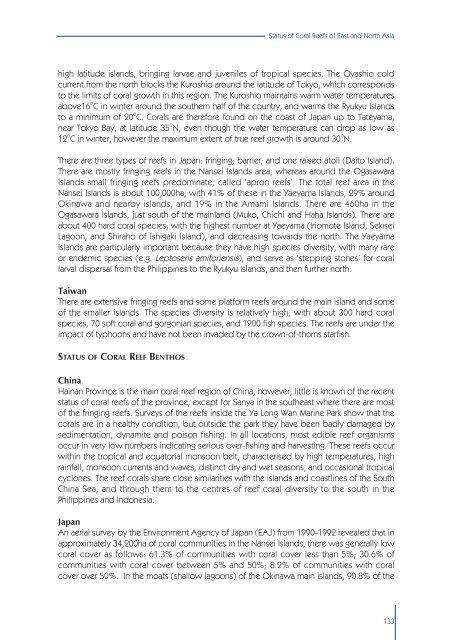Status of Coral Reefs of the World 2000
Status of Coral Reefs of the World 2000.pdf
Status of Coral Reefs of the World 2000.pdf
- No tags were found...
Create successful ePaper yourself
Turn your PDF publications into a flip-book with our unique Google optimized e-Paper software.
<strong>Status</strong> <strong>of</strong> <strong>Coral</strong> <strong>Reefs</strong> <strong>of</strong> East and North Asia<br />
high latitude islands, bringing larvae and juveniles <strong>of</strong> tropical species. The Oyashio cold<br />
current from <strong>the</strong> north blocks <strong>the</strong> Kuroshio around <strong>the</strong> latitude <strong>of</strong> Tokyo, which corresponds<br />
to <strong>the</strong> limits <strong>of</strong> coral growth in this region. The Kuroshio maintains warm water temperatures<br />
above16 o C in winter around <strong>the</strong> sou<strong>the</strong>rn half <strong>of</strong> <strong>the</strong> country, and warms <strong>the</strong> Ryukyu Islands<br />
to a minimum <strong>of</strong> 20 o C. <strong>Coral</strong>s are <strong>the</strong>refore found on <strong>the</strong> coast <strong>of</strong> Japan up to Tateyama,<br />
near Tokyo Bay, at latitude 35 o N, even though <strong>the</strong> water temperature can drop as low as<br />
12 o C in winter, however <strong>the</strong> maximum extent <strong>of</strong> true reef growth is around 30 o N.<br />
There are three types <strong>of</strong> reefs in Japan: fringing; barrier; and one raised atoll (Daito Island).<br />
There are mostly fringing reefs in <strong>the</strong> Nansei Islands area, whereas around <strong>the</strong> Ogasawara<br />
Islands small fringing reefs predominate, called ‘apron reefs’. The total reef area in <strong>the</strong><br />
Nansei Islands is about 100,000ha, with 41% <strong>of</strong> <strong>the</strong>se in <strong>the</strong> Yaeyama Islands, 29% around<br />
Okinawa and nearby islands, and 19% in <strong>the</strong> Amami Islands. There are 460ha in <strong>the</strong><br />
Ogasawara Islands, just south <strong>of</strong> <strong>the</strong> mainland (Muko, Chichi and Haha Islands). There are<br />
about 400 hard coral species, with <strong>the</strong> highest number at Yaeyama (Iriomote Island, Sekisei<br />
Lagoon, and Shiraho <strong>of</strong> Ishigaki Island), and decreasing towards <strong>the</strong> north. The Yaeyama<br />
Islands are particularly important because <strong>the</strong>y have high species diversity, with many rare<br />
or endemic species (e.g. Leptoseris amitoriensis), and serve as ‘stepping stones’ for coral<br />
larval dispersal from <strong>the</strong> Philippines to <strong>the</strong> Ryukyu Islands, and <strong>the</strong>n fur<strong>the</strong>r north.<br />
Taiwan<br />
There are extensive fringing reefs and some platform reefs around <strong>the</strong> main island and some<br />
<strong>of</strong> <strong>the</strong> smaller islands. The species diversity is relatively high, with about 300 hard coral<br />
species, 70 s<strong>of</strong>t coral and gorgonian species, and 1200 fish species. The reefs are under <strong>the</strong><br />
impact <strong>of</strong> typhoons and have not been invaded by <strong>the</strong> crown-<strong>of</strong>-thorns starfish.<br />
STATUS OF CORAL REEF BENTHOS<br />
China<br />
Hainan Province is <strong>the</strong> main coral reef region <strong>of</strong> China, however, little is known <strong>of</strong> <strong>the</strong> recent<br />
status <strong>of</strong> coral reefs <strong>of</strong> <strong>the</strong> province, except for Sanya in <strong>the</strong> sou<strong>the</strong>ast where <strong>the</strong>re are most<br />
<strong>of</strong> <strong>the</strong> fringing reefs. Surveys <strong>of</strong> <strong>the</strong> reefs inside <strong>the</strong> Ya Long Wan Marine Park show that <strong>the</strong><br />
corals are in a healthy condition, but outside <strong>the</strong> park <strong>the</strong>y have been badly damaged by<br />
sedimentation, dynamite and poison fishing. In all locations, most edible reef organisms<br />
occur in very low numbers indicating serious over-fishing and harvesting. These reefs occur<br />
within <strong>the</strong> tropical and equatorial monsoon belt, characterised by high temperatures, high<br />
rainfall, monsoon currents and waves, distinct dry and wet seasons, and occasional tropical<br />
cyclones. The reef corals share close similarities with <strong>the</strong> islands and coastlines <strong>of</strong> <strong>the</strong> South<br />
China Sea, and through <strong>the</strong>m to <strong>the</strong> centres <strong>of</strong> reef coral diversity to <strong>the</strong> south in <strong>the</strong><br />
Philippines and Indonesia.<br />
Japan<br />
An aerial survey by <strong>the</strong> Environment Agency <strong>of</strong> Japan (EAJ) from 1990-1992 revealed that in<br />
approximately 34,200ha <strong>of</strong> coral communities in <strong>the</strong> Nansei Islands, <strong>the</strong>re was generally low<br />
coral cover as follows: 61.3% <strong>of</strong> communities with coral cover less than 5%; 30.6% <strong>of</strong><br />
communities with coral cover between 5% and 50%; 8.2% <strong>of</strong> communities with coral<br />
cover over 50%. In <strong>the</strong> moats (shallow lagoons) <strong>of</strong> <strong>the</strong> Okinawa main islands, 90.8% <strong>of</strong> <strong>the</strong><br />
133
















